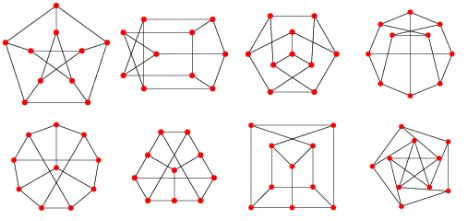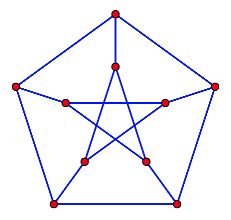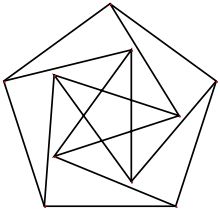Symmetry, Automorphims, and Isometries
Prepared by:
Joseph Malkevitch
Department of Mathematics and Computer Studies
York College (CUNY)
Jamaica, New York
email:
malkevitch@york.cuny.edu
web page:
http://york.cuny.edu/~malk/
Figure 1 shows a variety of drawings in the plane of the Petersen Graph, named for Julius Petersen (1839-1910).

Figure 1
The Petersen Graph is a non-planar graph, which means that no matter how hard one tries to draw it in the plane so that edges meet only at vertices, one can not accomplish this. The Petersen Graph has many nice properties including the fact that it does not have a hamiltonian circuit. As graphs, all of the diagrams above show isomorphic copies of the same graph.
Using the word "symmetric" informally, the diagrams do not all seem equally symmetric. We can capture this intuitive observation with some more precise ideas.
An automorphism of a graph G is a one-to-one, onto mapping of the vertices of G onto the vertices of G such that edges are preserved. The collection of all automorphisms of a graph form a mathematical structure known as the automorhism group of the graph. The group operation is performing one automorphism followed by another. Sometimes the order in which the operations is done will not matter in a group and in this case the group is called abelian. Some automorphism groups are abelian and some are not. Loosely speaking, the size of the number of elements in the automorphism group of a graph measures how symmetrical the graph is. The automorhism group of the Petersen Graph has 120 elements and this group is isomorphic as a group to what is called the Symmetric Group on 5 elements. One way of thinking of this the symmetric group on n elements is that it is all of the ways of permuting n symbols among themselves, so the group will have order n!.
However, if you look at the individual diagrams in Figure 1 as metrical rather than combinatorial objects we get a very different impression. Figure 2 shows one of the drawings from Figure 1.

Figure 2
Notice that not all of the edges in this diagram have the same length, an issue which does not matter for the automorphism group of the graph shown but does matter if we are interested in distance preserving transformations which transform this particular diagram into itself. Such geometric transformations are known as isometries. The isometries that you are familiar with which preserve Euclidean distance are translations, rotations, reflections, and glide reflections. In the situation here we are not looking for isometries of a tiling or infinite pattern in the plane but for a bounded object. Thus, for this situation we can limit the isometries that we need look for to rotations and reflections (mirror symmetry). Figure 2 has 5 rotational symmetries (including the rotation that does not move the diagram) and 5 additional mirror symmetries. The symmetry group of this diagram, has 10 elements, and is known as the dihedral group D5. More generally, Dn has 2n elements. The dihedral group of order 2n is the symmetry group of the regular n-gon in the Euclidean plane.
Figure 3 shows an interesting drawing of the Petersen graph which is different from any of those in Figure 1. Can you see what is special about this drawing?

Figure 3
If you interpret the location of the 10 vertices properly (when done in the way I have in mind, all of the vertices will have valence 3), All of the edges in Figure 3 have length 1 and we have a drawing of the Petersen graph.
Exercise: Determine the number of elements in the isometry group of each of the diagrams in Figure 1 and the diagram in Figure 3.
Reference:
Holton, D. and J. Sheehan, The Petersen Graph, Cambridge U. Press, 1993.


